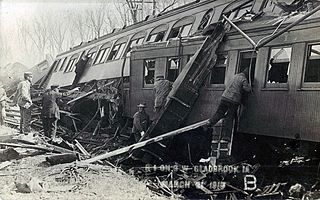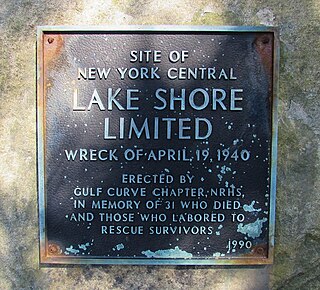Related Research Articles

Connellsville is a city in Fayette County, Pennsylvania, United States, 36 miles (58 km) southeast of Pittsburgh and 50 miles (80 km) away via the Youghiogheny River, a tributary of the Monongahela River. It is part of the Pittsburgh metropolitan area. The population was 7,031 at the 2020 census.

Rockwood is a borough in Somerset County, Pennsylvania, United States. The population was 850 at the 2020 census. It is part of the Johnstown, Pennsylvania, Metropolitan Statistical Area, and located due north of Pennsylvania's highest peak, Mount Davis, which significantly constricts land travel routing south of the municipality.
The Pittsburgh and Lake Erie Railroad, also known as the "Little Giant", was formed on May 11, 1875. Company headquarters were located in Pittsburgh, Pennsylvania. The line connected Pittsburgh in the east with Youngstown, Ohio, in the Haselton neighborhood in the west and Connellsville, Pennsylvania, to the east. It did not reach Lake Erie until the formation of Conrail in 1976. The P&LE was known as the "Little Giant" since the tonnage that it moved was out of proportion to its route mileage. While it operated around one tenth of one percent of the nation's railroad miles, it hauled around one percent of its tonnage. This was largely because the P&LE served the steel mills of the greater Pittsburgh area, which consumed and shipped vast amounts of materials. It was a specialized railroad, deriving much of its revenue from coal, coke, iron ore, limestone, and steel. The eventual closure of the steel mills led to the end of the P&LE as an independent line in 1992.

The Western Maryland Railway was an American Class I railroad (1852–1983) that operated in Maryland, West Virginia, and Pennsylvania. It was primarily a coal hauling and freight railroad, with a small passenger train operation.

The Delaware-Lackawanna Railroad is a shortline railroad operating in Northeastern Pennsylvania, especially the Scranton area.

Haines Falls is an abandoned train station in Haines Falls, New York. It was owned by the Ulster and Delaware Railroad. The abandoned station was restored in 1999 and is one of two surviving U&D branch stations. It is now the headquarters of the Mountain Top Historical Society. It is also the start of the Kaaterskill Rail Trail, a scenic hiking trail along the former railway.

The Susquehanna and New York Railroad was a short-line railroad connecting the Lehigh Valley Railroad at Towanda, Pennsylvania, with the Pennsylvania Railroad at Marsh Hill Junction. The railroad carried freight and passengers between Williamsport and Towanda by rail rather than using the Susquehanna River or the Pennsylvania Canal.

The Angola Horror train wreck occurred on December 18, 1867, just after 3 p.m. when the last coach of the Buffalo-bound New York Express of the Lake Shore Railway derailed at a bridge in Angola, New York, United States, slid down into a gorge, and caught fire, killing some 49 people. At the time, it was one of the deadliest train wrecks in American history.

The New Market train wreck happened when two Southern Railway passenger trains traveling at great speed collided head on near New Market, Tennessee, on Saturday, September 24, 1904, killing at least 56 passengers and crew and injuring 106.

The Green Mountain train wreck is the worst ever railroad accident in the state of Iowa. It occurred between Green Mountain and Gladbrook on the morning of March 21, 1910, and killed 52 people.
The Custer Creek train wreck is the worst rail disaster in Montana history. It occurred on June 19, 1938 when a bridge, its foundations washed away by a flash flood, collapsed beneath Milwaukee Road's Olympian as it crossed Custer Creek, near Saugus, Montana, south-west of Terry, killing at least 47 people.

The South Bend Train Wreck occurred on June 27, 1859, between Mishawaka and South Bend in Indiana on the Michigan Southern Railroad killing 42 people and injuring 50 more.

The Glenrock train wreck is the worst train wreck in Wyoming history, killing 30. It happened on the Chicago, Burlington and Quincy Railroad between Glenrock and Casper on September 27, 1923.. It occurred when the Casper to Denver train, only 15 miles into its journey, plunged into Cole Creek after the bridge spanning it had washed away after three days of storms.
The Fast Mail was a Southern Railway mail and express train that operated between Washington, D.C., and New Orleans, Louisiana. The southbound Fast Mail carried the train number of 97, and was later known by the nickname of "Old 97". One such trip made by the train, on September 27, 1903, derailed at Stillhouse Trestle in Danville, Virginia, and was later known as the "Wreck of the Old 97", for which the service was most well known.

Essex Fells was the terminus of the Erie Railroad's Caldwell Branch in the Essex County community of Essex Fells, New Jersey. Located at the junction of Oak Lane and Chestnut Lane in Essex Fells, the station was also a connection to the Morristown and Erie Railroad, which continued west through Roseland towards Morristown. The next station north from the Essex Fells station was Caldwell heading northward to Great Notch in Little Falls, where the line connected to the New York and Greenwood Lake Railroad.

The East Paris train wreck was a head-on collision between two trains, which occurred on the Pere Marquette Railway on December 26, 1903. The crash was caused after a westbound stop signal was blown out by strong winds, causing the westbound train to fail to stop, and collide with an eastbound train.

A train crash with fatalities occurred shortly after 11:30 p.m. on April 19, 1940, when a first-class westbound Lake Shore Limited operated by the New York Central Railroad, derailed near Little Falls, New York, United States. The accident was later found to have occurred due to excessive speed on the Gulf Curve, the sharpest on the Central's lines. It killed 31; an additional 51 were injured.

On the night of Wednesday, June 21, 1905, the New York Central Railroad's flagship passenger train, the 20th Century Limited, derailed in Mentor, Ohio, on the Lake Shore and Michigan Southern Railway line, killing 21 passengers and injuring more than 25 others on board. A switch from the mainline to a freight siding was open, causing the Limited to leave the mainline and overrun the siding at high speed. The cause of the accident was never officially determined, but overwhelming evidence points to an act of rail sabotage. The 20th Century Limited connected New York City to Chicago; its running time had just weeks earlier been reduced from 20 hours to 18.
References
- ↑ Haine 1993, p. 31.
- ↑ "Laurel Run, PA Train Wreck, Dec 1903 - Sixty Three Dead". Ogdensburg Advance and St. Lawrence Weekly Democrat. submitted by Stu Beitler. December 23, 1903. Archived from the original on March 26, 2012. Retrieved June 17, 2010– via Gendisasters.
{{cite news}}: CS1 maint: others (link) - 1 2 3 "Laurel Run, PA Train Wreck, Dec 1903 - Sixty Dead in Wreck". The New York Times. submitted by Linda Horton. New York, NY. December 24, 1903. Archived from the original on March 26, 2012. Retrieved June 17, 2010– via Gendisasters.
{{cite news}}: CS1 maint: others (link)
"Sixty Dead in Railway Wreck". The New York Times. New York, NY. December 24, 1903. p. 1 – via Newspapers.com.
- 1 2 3 "Laurel Run, PA Passenger Train Strikes Debris, Dec 1903 - 70 Dead". The Courier. submitted by Stu Beitler. Connellsville, Pennsylvania. December 24, 1903. Archived from the original on March 26, 2012. Retrieved June 17, 2010– via Gendisasters.
{{cite news}}: CS1 maint: others (link)
"Seventy Persons Killed in Duquesne Limited Wreck". The Courier. Connellsville, Pennsylvania. December 24, 1903. p. 1 – via Newspapers.com. ,
, - ↑ "Laurel Run, PA Train Wreck, Dec 1903 - Disastrous Wreck". The Philadelphia Inquirer. submitted by Linda Horton. December 24, 1903. Archived from the original on March 26, 2012. Retrieved June 17, 2010– via Gendisasters.
{{cite news}}: CS1 maint: others (link) - ↑ "Laurel Run, PA Train Wreck, Dec 1903 - Victims Total 64". The New York Times. submitted by Linda Horton. December 25, 1903. Archived from the original on March 26, 2012. Retrieved June 17, 2010– via Gendisasters.
{{cite news}}: CS1 maint: others (link)
"Train Wreck Victims Total Sixty-Four". The New York Times. New York, NY. December 25, 1903. p. 3 – via Newspapers.com.
- 1 2 Haine 1993, pp. 64–65.
- Haine, Edgar A. (1993). Railroad Wrecks. New York, London and Toronto: Cornwall Books. ISBN 9780845348444 – via Google Books.